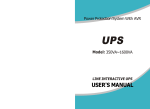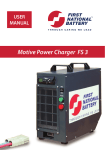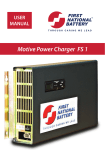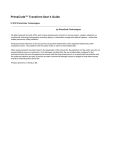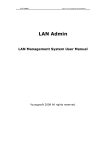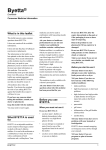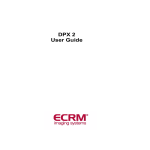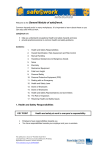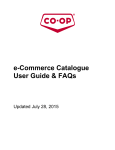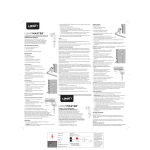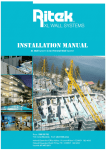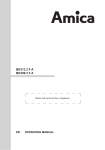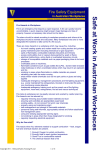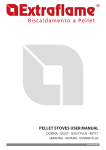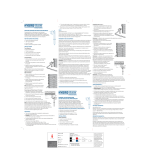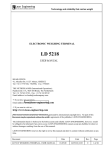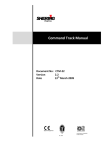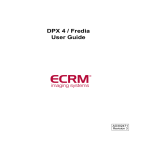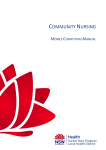Download Forklift-FInal Review Guide Sample
Transcript
d i P u ty M yG P a i s l Final Review a r Ea t s u Study Guide A s d E ide t L L P y u t M G P Forklift a SA asy i l a r E t s © u Truck LICENCE A d E ides t L L P y u t M G P a SA asy i l a r E t s © u A E ides EASY L Pand u Includes practical GUIDES ty M G P knowledgeA training tasks a S asy i l a Training support material for: tliliC2001a – licence to operate a forklift truck Produced by: Australia Pty Ltd d i P u ty M yG P a i s l a r Ea t s u A s d E ide t L L P y u t M G P a SA asy i l a r E t s © u A d E ides t L L P y u t M G P a SA asy i l a r E t s © u A E ides L P y u t M G P a SA asy i l a INTRODUCTION TO FORKLIFT TRUCKs what is a forklift truck? A forklift is a powered industrial truck used to lift and move loads. It has a mast and an elevating load carriage with a pair of fork arms or other load-holding parts. As you can see below, there are different types of forklifts. The most common forklift is the counterbalance forklift truck. This series of images were used with permission from Linde Counterbalance forklift truck. Stand-on reach forklift truck. Double-deep reach forklift truck. Rough terrain forklift truck. Narrow aisle forklift truck. Sit-on reach forklift truck. © Easy Guides Australia Pty. Ltd. 5 May not be reproduced. d i P u ty M yG P a i s l a r Ea t s u A s d E ide t L L P y u t M G P a SA asy i l a r E t s © u A d E ides t L L P y u t M G P a SA asy i l a r E t s © u A E ides L P y u t M G P a SA asy i l a INTRODUCTION TO FORKLIFT TRUCKs Parts of a forklift truck Overhead guard Flashing hazard light Head lamp Operator’s seat Mirror Gas bottle Hydraulic controls Seat belt Instrument panel Data plate/ load chart/rating plate Mast Counterweight Lift chain Fuel cap Lift cylinder Assist grip Backrest Engine hood Locking pins Vertical face of fork C Fork carriage Fork (tyne) Heel N OU TE R I WE GH T Rear wheel Foot step Tilt cylinder Front wheel © Easy Guides Australia Pty. Ltd. 6 May not be reproduced. d i P u ty M yG P a i s l a r Ea t s u A s High Risk Licensing and the LLaw d E ide t L P y u t M G P a SA asy i l a r E t s © u A d E ides t L L P y u t M G P a SA asy i l a r E t s © u A E ides L P y u t M G P a SA asy i l a Required Knowledge 2.0 © Easy Guides Australia Pty. Ltd. 7 May not be reproduced. d i P u ty M yG P a i s l a r Ea t s u A s d E ide t L L P y u t M G P a SA asy i l a r E t s © u A d E ides t L L P y u t M G P a SA asy i l a r E t s © u A E ides L P y u t M G P a SA asy i l a high risk licensing and the law QUESTION RK 2 (A) Can a PCBU/employer (boss) let you do high risk licence work if you are not fully trained? No. By law, your PCBU/employer must make sure you are trained and competent to do high risk work. Yes. If you are enrolled in a course of high risk work (HRW) and supervised by a person with that HRW licence. Note: Your PCBU/employer will not let you do high risk licence work if he or she believes you are not competent. QUESTION RK 2 (B) You have a high risk work licence. Under WHS/OHS laws, what are your responsibilities while working? You must work in a way that is safe. You must not risk the health and safety of yourself or others. You must be careful the whole time you are doing high risk work. © Easy Guides Australia Pty. Ltd. 8 May not be reproduced. d i P u ty M yG P a i s l a r Ea t s u A s Dtd E ide E L L L P L y u t E M yG P C A N a S as i A l C a r E t s © u A s d E ide t L L P y u t M G P a SA asy i l a r E t s © u A E ides L P y u t M G P a SA asy i l a high risk licensing and the law QUESTION RK 2 (C) You may have your licence suspended or cancelled. You can be punished (penalised) for not doing high risk licence work safely. What might the punishment be? You may not be able to renew your licence. © Easy Guides Australia Pty. Ltd. 9 May not be reproduced. d i P u ty M yG P a i s l a r Ea t s u A s Plan work d E ide t L L P y u t M G P a SA asy i l a r E t s © u A d E ides t L L P y u t M G P a SA asy i l a r E t s © u A E ides L P y u t M G P a SA asy i l a element 1 © Easy Guides Australia Pty. Ltd. 13 May not be reproduced. d i P u ty M yG P a i s l a r Ea t s u A s d E ide t L L P y u t M G P a SA asy i l a r E t s © u A d E ides t L L P y u t M G P a SA asy i l a r E t s © u A E ides L P y u t M G P a SA asy i l a plan work QUESTION 1.1 (A) Your manager, supervisor or team leader. Workmates. WHS representatives or safety officer. Site engineers. Who might you talk to about site hazards before you start the job? © Easy Guides Australia Pty. Ltd. 14 May not be reproduced. d i P u ty M yG P a i s l a r Ea t s u A s d E ide t L L P y u t M G P a SA asy i l a r E t s © u A d E ides t L L P y u t M G P a SA asy i l a r E t s © u A E ides L P y u t M G P a SA asy i l a plan work QUESTION 1.1 (B) You need to communicate with people on a work site (such as workplace health and safety representatives) before you start work. Why do you think it is important to do this? QUESTION 1.1 (C) A restricted space is somewhere that doesn’t have much space or fresh air. It can be dangerous to use a forklift with a combustion engine in a restricted space. Why? © Easy Guides Australia Pty. Ltd. To help you follow the rules and work procedures for the site. This helps keep you and others safe. Combustion engines create gasses that can stop you breathing properly. You could become unconscious. If you didn’t get help, you could die. 15 May not be reproduced. d i P u ty M yG P a i s l a r Ea t s u A s d E ide t L L P y u t M G P a SA asy i l a r E t s © u A d E ides t L L P y u t M G P a SA asy i l a r E t s © u A E ides L P y u t M G P a SA asy i l a plan work QUESTION 1.1 (F) You need to plan for possible hazards before you use the forklift. The hazards could be inside or outside. Overhead services lines Name some hazards you might have to plan for inside. Other equipment working in the area Doorways Areas with poor lighting Dangerous materials in the work area Obstructions Other hazards unique to your workplace © Easy Guides Australia Pty. Ltd. Pedestrians 17 May not be reproduced. d i P u ty M yG P a i s l a r Ea t s u A s d E ide t L L P y u t M G P a SA asy i l a r E t s © u A d E ides t L L P y u t M G P a SA asy i l a r E t s © u A E ides L P y u t M G P a SA asy i l a plan work QUESTION 1.1 (G) You need to plan for possible hazards before you use the forklift. The hazards could be inside or outside. Powerlines or overhead service lines Surrounding buildings Trees Name some hazards you might have to plan for outside. Other plant and equipment Pavement obstructions Railway crossings and other hazards unique to your workplace Underground services Pedestrians © Easy Guides Australia Pty. Ltd. 18 May not be reproduced. d i P u ty M yG P a i s l a r Ea t s u A s Conduct routine checks d E ide t L L P y u t M G P a SA asy i l a r E t s © u A d E ides t L L P y u t M G P a SA asy i l a r E t s © u A E ides L P y u t M G P a SA asy i l a element 2 © Easy Guides Australia Pty. Ltd. 29 May not be reproduced. d i P u ty M yG P a i s l a r Ea t s u A s d E ide t L L P y u t M G P a SA asy i l a r E t s © u A d E ides t L L P y u t M G P a SA asy i l a r E t s © u A E ides L P y u t M G P a SA asy i l a conduct routine checks QUESTION 2.4 (A) Some of the things you should check are: A pre-operational check is done before using the forklift truck. Fuels such as petrol, LPG, or diesel. Tyres. Check that they are pumped up (inflated) and not damaged. Oil, water and other liquids such as hydraulic fluid. Data plates to make sure your forklift can carry the load. Mast to make sure chain and pulleys are in good condition. All guards, such as roll-over or falling objects protection guards. What are some pre-operational checks you should do before using a forklift truck? A checklist is a good way to make sure you have checked everything Mon CHECK DAILY BEFORE EACH SHIFT: ] = OK [ ] = Action needed Machine Hour Meter / Machine No: Company/Site [ / Week Starting FORKLIFT - Daily Inspection Checklist Shift [N/A] = Not applicable / / Thur Wed Tue Shift Shift Shift D A N D A N D A N Frid Shift Sat Shift Sun Shift D A N D A N D A N D A N Check load-capacity plate is fitted, legible and correct. Inspect forks for any signs of damage. Check tyres, belts and look for any leaks under the truck. Check mast and hydraulic cylinders, look for any leaks. Check all fluids: oil, hydraulics, battery, fuel, coolant... Gas bottle and/or battery: security, hose connections and gauge. Check condition and adjustment of seat and belt. After start up check all pedals and controls for smooth operation. Check brakes and parking brake for proper operation. Check lights, horn and reversing beeper. Any other visible damage or defects. Operator doing check to clearly write/sign their name at the bottom of each column. FAULT REPORTED BY Description of fault DANGER Date: DO NOT OPERATE TAG PLACED BY: DEPARTMENT: DATE: TIME: / ACTION TAKEN TO RETURN TO SERVICE / Print Name NOTE: Operator to TAG OUT machine if needed. Date / / Signature Check attachments are secure. Tynes (forks) to make sure they are not cracked or bent. Carbon checklist books are available from www.easyguides.com.au © Easy Guides Australia Pty. Ltd. 33 May not be reproduced. d i P u ty M yG P a i s l a r Ea t s u A s d E ide t L L P y u t M G P a SA asy i l a r E t s © u A d E ides t L L P y u t M G P a SA asy i l a r E t s © u A E ides L P y u t M G P a SA asy i l a conduct routine checks QUESTION 2.4 (B) 1. Take out the keys. 2. Put a danger tag on the forklift so no one else can use it. 3. Write the problem in the logbook. 4. Tell your supervisor. You have found a problem with your forklift truck. What should you do? Sam Simpson 21 03 Punctured tyre QUESTION 2.4 (C) What checks do you do for a forklift with solid rubber tyres? Check that tyre wear is even Check the tyre is not worn down to its wear limit line Check no big pieces of rubber are missing © Easy Guides Australia Pty. Ltd. 34 May not be reproduced. d i P u ty M yG P a i s l a r Ea t s u A s d E ide t L L P y u t M G P a SA asy i l a r E t s © u A d E ides t L L P y u t M G P a SA asy i l a r E t s © u A E ides L P y u t M G P a SA asy i l a conduct routine checks QUESTION 2.5 (A) How should you get on and off your forklift truck? You should get on and off the forklift from the left side. Three (3) parts of your body should touch the forklift at the same time: both hands and one foot, or both feet and one hand is best. Never jump off the forklift. QUESTION 2.6 (A) 1. Take out the keys. 2. Put a danger tag on the forklift so no one else can use it. 3. Write the problem in the logbook. 4. Tell your supervisor. You are using the forklift and hear strange noises. What do you do? Sam Simpson 21 03 Punctured tyre © Easy Guides Australia Pty. Ltd. 35 May not be reproduced. d i P u ty M yG P a i s l a r Ea t s u A s d E ide t L L P y u t M G P a SA asy i l a r E t s © u A d E ides t L L P y u t M G P a SA asy i l a r E t s © u A E ides L P y u t M G P a SA asy i l a conduct routine checks QUESTION 2.6 (B) Some checks you should do are: You need to do post-start checks to check the forklift is safe and working properly. Check the steering. Check the brakes. Check that all controls work properly. Check warning devices (horn, beeper). Check the lights. Check the gauges. What are some post-start checks you should do after you have started the forklift truck? Check that the forklift moves properly in all directions. © Easy Guides Australia Pty. Ltd. 36 May not be reproduced. d i P u ty M yG P a i s l a r Ea t s u A s Shift loads d E ide t L L P y u t M G P a SA asy i l a r E t s © u A d E ides t L L P y u t M G P a SA asy i l a r E t s © u A E ides L P y u t M G P a SA asy i l a element 3 © Easy Guides Australia Pty. Ltd. 41 May not be reproduced. d i P u ty M yG P a i s l a r Ea t s u A s d E ide t L L P y u t M G P a SA asy i l a r E t s © u A d E ides t L L P y u t M G P a SA asy i l a r E t s © u A E ides L P y u t M G P a SA asy i l a SHIFT loadS QUESTION 3.1 (A) What are some ways you can find out the weight of a load? © Easy Guides Australia Pty. Ltd. Checking the weighbridge note, consignment note, or other information. Weighing the load. Calculating the weight of the load. For example: 50 kg × 6 = 300 kg Reading the weight on the load. 50 kg 50 kg 50 kg 50 kg 50 kg 50 kg 43 May not be reproduced. d i P u ty M yG P a i s l a r Ea t s u A s d E ide t L L P y u t M G P a SA asy i l a r E t s © u A d E ides t L L P y u t M G P a SA asy i l a r E t s © u A E ides L P 1135 kg y u t M G P a SA asy i l a SHIFT loadS QUESTION 3.1 (B) 44 × 25 kg = 1100 kg You have to move a load of 44 bags of flour on a pallet. Weight of pallet = 35 kg Total weight of load = 1135 kg • Each bag weighs 25 kg • Pallet weighs 35 kg What is the total weight of the load? Show how you worked it out. 44 bags of flour 1100 kg + Pallet 35 kg = © Easy Guides Australia Pty. Ltd. 44 May not be reproduced. d i P u ty M yG P a i s l a r Ea t s u A s d E ide t L L P y u t M G P a SA asy i l a r E t s © u A d E ides t L L P y u t M G P a SA asy i l a r E t s © u A E ides 635 kg L P y u t M G P a SA asy i l a SHIFT loadS QUESTION 3.1 (C) Total weight = cartons × layers × carton weight + pallet There is a load to be moved. The load is stacked cartons on a pallet. Total weight = 4 × 6 × 25 + 35 Total weight = 635 kg • Four (4) cartons per layer • Six (6) layers • One (1) carton = 25 kg • Pallet = 35 kg 1 box = 25 kg What is the total weight? Show your working out. 4 cartons × 25 kg × 6 layers = 600 kg + Pallet 35 kg = © Easy Guides Australia Pty. Ltd. 45 May not be reproduced. d i P u ty M yG P a i s l a r Ea t s u A s d E ide t L L P y u t M G P a SA asy i l a r E t s © u A d E ides t L L P y u t M G P a SA asy i l a r E t s © u A E ides L P y u t M G P a SA asy i l a SHIFT loadS QUESTION 3.6 (D) You must give way to emergency vehicles, such as ambulances, police and fire trucks. There has been an accident on your worksite. Which vehicles have the right of way in an emergency? end of Shift loads section. Check your knowledge by answering the questions for Shift loads at the end of the book. your trainer will check your answers. © Easy Guides Australia Pty. Ltd. 72 May not be reproduced. d i P u ty M yG P a i s l a r Ea t s Shut down and u A s d E ide secure forklift truck t L L P y u t M G P a SA asy i l a r E t s © u A d E ides t L L P y u t M G P a SA asy i l a r E t s © u A E ides L P y u t M G P a SA asy i l a element 4 © Easy Guides Australia Pty. Ltd. 73 May not be reproduced. d i P u ty M yG P a i s l a r Ea t s u A s d E ide t L L P y u t M G P a SA asy i l a r E t s © u A d E ides t L L P y u t M G P a SA asy i l a r E t s © u A E ides L P y u t M G P a SA asy i l a shut down and secure forklift truck QUESTION 4.2 (A) Follow the correct shutdown procedures. For example: List three (3) things you need to do when shutting down the forklift? Park the forklift away from hazards. Put the forklift arms on to the ground and use the forward tilt. Put the forklift into neutral (N) gear. Put the handbrake on. Turn off the engine. Take out the key. Get off the forklift properly. Make sure you are touching the forklift with three (3) body parts. Turn off the gas cylinder valve, or charge the battery (if the battery is needed). Update the logbook and do a post-operational (after) check on the forklift. © Easy Guides Australia Pty. Ltd. 76 May not be reproduced. d i P u ty M yG P a i s l a r Ea t s u A s d E ide t L L P y u t M G P a SA asy i l a r E t s © u A d E ides t L L P y u t M G P a SA asy i l a r E t s © u A E ides L P y u t M G P a SA asy i l a shut down and secure forklift truck QUESTION 4.3 (A) Some checks might include the following: List three (3) post operational checks you should do when finished using a forklift? Wipe the controls and seat. Look for leaks on and under the forklift. Make sure everything is closed off and turned off. Walk around the forklift and look for damage. Make sure it is safe for the next person. Always check your user manual © Easy Guides Australia Pty. Ltd. 77 May not be reproduced. d i P u ty M yG P a i s l a r Ea t s u A s d E ide t L L P y u t M G P a SA asy i l a r E t s © u A d E ides t L L P y u t M G P a SA asy i l a r E t s © u A E ides L P y u t M G P a SA asy i l a shut down and secure forklift truck QUESTION 4.4 (A) Why do you need to take out the ignition key when leaving the forklift unattended (by itself)? QUESTION 4.5 (A) To stop the forklift truck being moved by someone who is unauthorised (does not have permission). 1. Take out the keys. 2. Put a danger tag on the forklift so no one else can use it. 3. Write the problem in the logbook. 4. Tell your supervisor. You are doing the postoperational checks. You find a problem with the forklift truck. What should you do? Sam Simpson 21 03 Punctured tyre end of Shut down and secure forklift truck section. Check your knowledge by answering the questions for Shut down and secure forklift truck at the end of the book. your trainer will check your answers. © Easy Guides Australia Pty. Ltd. 78 May not be reproduced.

























